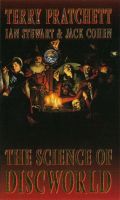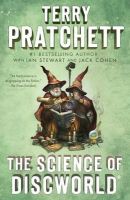 Title: The Science of Discworld
Title: The Science of Discworld
Author(s): Terry Pratchett, Ian Stewart, Jack Cohen
Release year: 1999
Publisher: Ebury Press
Why in Database: Science of the DiscWorld is the first (and the only one without a subtitle) volume of a four-book series. These books can definitely be called popular science, with the addition of Discworld. The chapters are arranged in turns, one about the magicians from the unseen university (generally shorter) and one about science in a broad sense, in the first volume they are about the creation of the world and life in it. As this book balances between the real world and the disc, there are (in both perspectives) references to turtles. Below are some examples (mostly longer pieces), but they are not all turtle elements in the book (we omitted the less “unique” ones).
The first fragment that comes before the main part of the book begins, one of the four quotes at the very beginning is about turtles:
There are no turtles anywhere.
Ponder Stibbons
The second fragment is an explanation why Science is different than the typical book “Science of Insert_name_of_universe”, where pseudoscientific ideas are described to explain why X and Y work in the series and so on:
We could have taken that approach. We could, for example, have pointed out that Darwin’s theory of evolution explains how lower lifeforms can evolve into higher ones, which in turn makes it entirely reasonable that a human should evolve into an orangutan (while remaining a librarian, since there is no higher life form than a librarian). We could have speculated on which DNA sequence might reliably incorporate asbestos linings into the insides of dragons. We might even have attempted to explain how you could get a turtle ten thousand miles long.
We decided not to do these things, for a good reason … um, two reasons.
The first is that it would be … er … dumb.
The next section we have chosen is about the relationship between turtles and the moon:
Creatures lower on the evolutionary ladder were certainly aware of the Moon. Take the turtle, for
instance – about as Discwordly a beast as you can get. When today’s turtles crawl up the beach to lay their
eggs and bury them in the sand, they somehow choose their timing so that when the eggs hatch, the baby
turtles can scramble towards the sea by aiming at the Moon. We know this because the lights of modern buildings confuse them. This behaviour is remarkable, and it’s not at all satisfactory to put it down to ’instinct’ and pretend that’s an answer. What is instinct? How does it work? How did it arise? A scientist wants plausible answers to such questions, not just an excuse to stop thinking about them. Presumably the baby turtles’ moonseeking tendencies, and their mothers’ uncanny sense of timing, evolved together. Turtles that just happened, by accident, to lay their eggs at just the right time for them to hatch when the Moon would be to seawards of their burial site, and whose babies just happened to head towards the bright lights, got more of the next generation back to sea than those that didn’t. All that was needed to establish these tendencies as a universal feature of turtle-hood was some way to pass them on to the next generation, which is where genes come in. Those turtles that stumbled on a workable navigational strategy, and could pass that strategy on to their offspring by way of their genes, did better than the others. And so they prospered, and outcompeted the others, so that soon the only turtles around were the ones that could navigate by the Moon.
Next fragment is again about the relationship between turtles and the moon:
The interesting thing about the terrestrial turtlish trickery is that at no stage is it necessary for the animals to be conscious that their timing is geared to the Moon’s motion, or even that the Moon exists. However, the trick won’t work unless the baby turtles notice the Moon, so we deduce that they did. But we can’t deduce the existence of some turtle astronomer who wondered about the Moon’s puzzling changes of shape.
The next fragment is quite a classic, an anecdote about “turtles all the way down“:
It now becomes impossible not to mention the turtle joke. According to Hindu legend, the Earth rides on the back of four elephants, which ride on a turtle. But what supports the turtle? In Discworld, Great A’Tuin needs no support, swimming through the universe unperturbed by any thought about what holds it up. That’s magic in action: world-carrying turtles are like that. But according to the old lady who espoused the Hindu cosmology, and was asked the same question by a learned astronomer, there is a different answer: ’It’s turtles all the way down!’ The image of an infinite pile of turtles is instantly ludicrous, and very few people find it a satisfying explanation. Indeed very few people find it a satisfying kind of explanation, if only because it doesn’t explain what supports the infinite pile of turtles. However, most of us are quite content to explain the origins of time as ’it’s always been there’. Seldom do we examine this statement closely enough to realize that what it really says is ’It’s time all the way back.’ Now replace ’time’ by ’turtle’ and ’back’ by ’down’ … Each instant of time is ’supported’, that is, a causal consequence of, the previous instant of time. Fine, but that doesn’t explain why time exists. What caused that infinite expanse of time? What holds up the whole pile?
Mention of Chelonium:
It is the same on Discworld, with its to our eyes bizarre elements such as chelonium (for making world-bearing turtles), elephantigen (ditto elephants), and narrativium – a hugely important ’element’ not just for Discworld, but for understanding our own world too.
The next two fragments are two different lists of rules that Ponder Stibbons made on the basis of his observations:
On the paper was written, in Ponder’s very neat handwriting:
THE RULES
1 Things fall apart, but centres hold.
2 Everything moves in curves.
3 You get balls.
4 Big balls tell space to bend.
5 There are no turtles anywhere.
6 … It’s so depressing.
THE RULES
1 Things fall apart, but centres hold
2 Everything moves in curves
3 You get balls
4 Big balls tell space to bend
5 There are no turtles anywhere
(after this one he’d added Except ordinary ones)
6 Life turns up everywhere it can
7 Life turns up everywhere it can’t
8 There is something like narrativium
9 There may be something called bloodimindium (see
rule 7)
10…
The last fragment we selected is about the unexpected protection that A’Tuin and elephants provide for the disc:
’Yes, but only as a result of argumentative wizardry. That’s quite different. You don’t expect rocks to drop out of the sky.’
’You don’t expect them to stay up? said Ridcully. ’In a proper universe, the turtle snaps up most of them and the elephants get the rest. Protects the world. Y’know, it seems to me that the most sensible thing any intelligent lifeform could do on that little world would be to get off it.’

Author: XYuriTT
